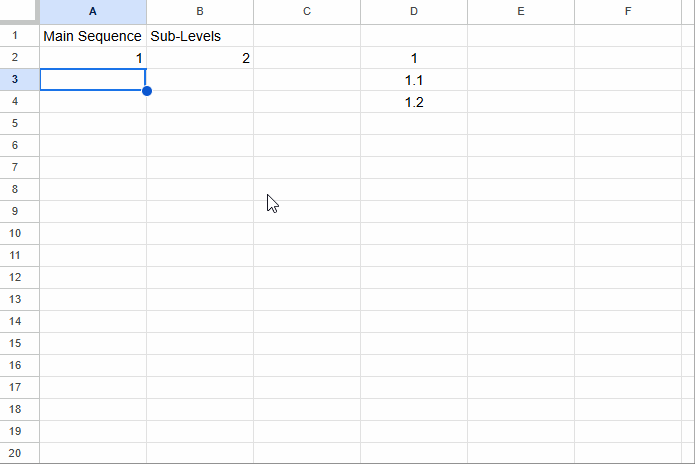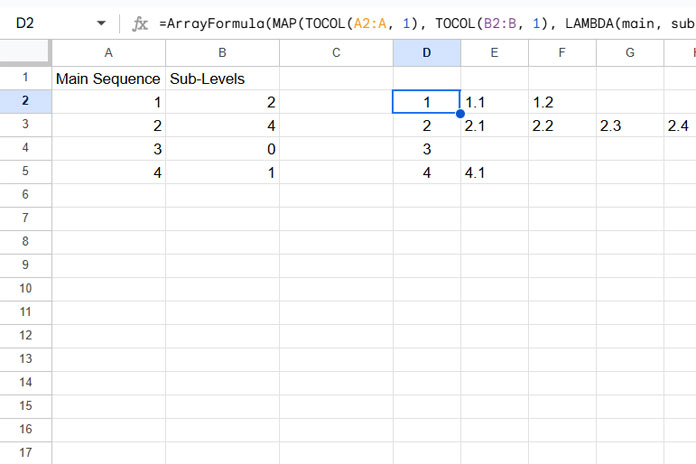If you want to number rows as 1, 1.1, 1.2, 1.3, 2, 2.1… in Google Sheets, you’re looking for a structured, outline-like approach to numbering. This can be achieved with a formula that lets you create sub-levels under each main row number. In this tutorial, we’ll show you how to set it up.
Setting Up Numbering Rows as 1, 1.1, 1.2, 1.3 in Google Sheets
This numbering style relies on defining two input columns. One column sets the main sequence (e.g., 1, 2, 3), and the other specifies each main number’s sub-levels. Here’s a step-by-step guide to create it in Google Sheets.

Sample Input Values
Here’s an example of the input in columns A and B:
| Main Sequence | Sub-Levels |
| 1 | 5 |
| 2 | 3 |
| 3 | 4 |
With this input, you’ll generate a list like this:
1
1.1
1.2
1.3
1.4
1.5
2
2.1
2.2
2.3
3
3.1
3.2
3.3
3.4
Formula to Number Rows as 1, 1.1, 1.2, 1.3 in Google Sheets
Once your main and sub-levels are set up in columns A and B, go to column C (starting in cell C2 or any empty cell) and paste this formula:
=ArrayFormula(
TOCOL(
MAP(TOCOL(A2:A, 1), TOCOL(B2:B, 1),
LAMBDA(main, sub,
TOROW(VSTACK(main, IF(sub>0, main&"."&SEQUENCE(sub),)))
)
), 1
)
)This formula will number rows as 1, 1.1, 1.2, and so on in Google Sheets, adapting to your main sequence and sub-level entries.
Explanation of the Formula
Here’s how this formula works to number rows as 1, 1.1, 1.2, 1.3 in Google Sheets.
1. Creating the Sub-Sequence with SEQUENCE
The SEQUENCE function generates a series from 1 to the specified sub-level number in column B. For example, if cell B2 contains 5, then:
=SEQUENCE(B2)This produces:
1
2
3
4
5
2. Combining the Main Sequence with Sub-Levels
Next, we combine column A’s main number with each sub-level SEQUENCE to create a 1.1, 1.2 style format. The formula for this is:
=ArrayFormula(IF(B2>0, A2 & "." & SEQUENCE(B2),))For example, if A2 is “1” and B2 is “5”, this formula returns:
1.1
1.2
1.3
1.4
1.5
If B2 is 0, the formula returns a blank cell instead of generating any sub-level numbers.
3. Stacking the Main Number with the Sub-Sequence
To keep the main number as the top value followed by sub-levels, we use VSTACK:
=ArrayFormula(VSTACK(A2, IF(B2>0, A2 & "." & SEQUENCE(B2),)))This will produce:
1
1.1
1.2
1.3
1.4
1.5
4. Ensuring a Single Row Format with TOROW
Using TOROW ensures that each hierarchical sequence is arranged in a single-row format (horizontally), as shown below:
=ArrayFormula(TOROW(VSTACK(A2, IF(B2>0, A2 & "." & SEQUENCE(B2),))))5. Applying the Formula to Multiple Rows with LAMBDA and MAP
To number rows as 1, 1.1, 1.2, 1.3 for every row in columns A and B, we convert this logic into a LAMBDA function:
=LAMBDA(main, sub, ArrayFormula(TOROW(VSTACK(main, IF(sub>0, main & "." & SEQUENCE(sub),)))))Here:
mainis the main number from column A.subis the sub-level count from column B.
We use MAP to apply this LAMBDA function to all rows in columns A and B:
=ArrayFormula(MAP(TOCOL(A2:A, 1), TOCOL(B2:B, 1), LAMBDA(main, sub, TOROW(VSTACK(main, IF(sub>0, main & "." & SEQUENCE(sub),))))))- MAP applies the function to each main and sub-level entry in columns A and B.
- TOCOL ensures the arrays from columns A and B are flattened, avoiding empty cells.

The outer TOCOL in the original formula flattens this result range.
This approach allows you to automatically number rows as 1, 1.1, 1.2, 1.3 in Google Sheets, providing flexible control over each main and sub-level.
You can use this method to organize data in an outline-like format directly within Google Sheets.
Resources
- Auto Serial Numbering in Google Sheets with Row Function
- Group Wise Serial Numbering in Google Sheets
- Group-Wise Dependent Serial Numbering in Google Sheets
- Insert Sequential Numbers Skipping Hidden | Filtered Rows in Google Sheets
- Skip Blank Rows in Sequential Numbering in Google Sheets
- Assign the Same Sequential Numbers to Duplicates in a List in Google Sheets
- Backward Sequence Numbering in Google Sheets
- Sequence Numbering in Merged Cells In Google Sheets
- How to Easily Repeat a Sequence of Numbers in Excel
- Hierarchical Numbering Sequences in Excel





















